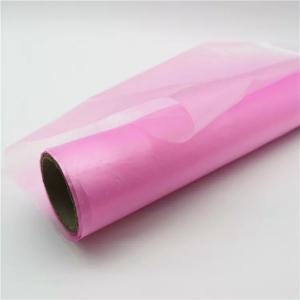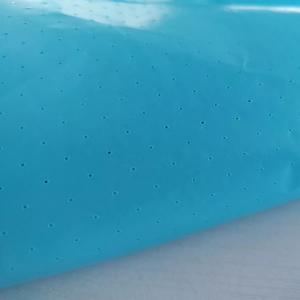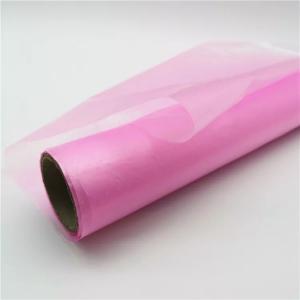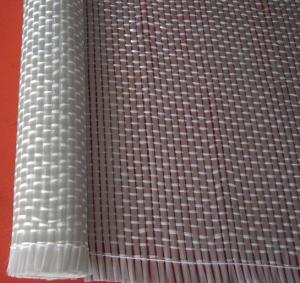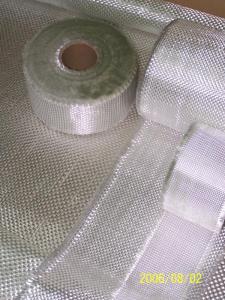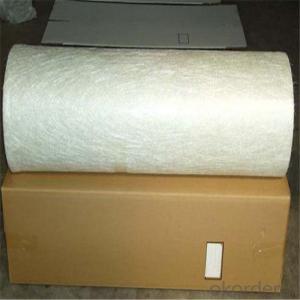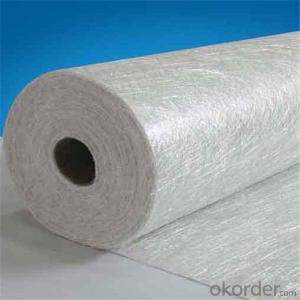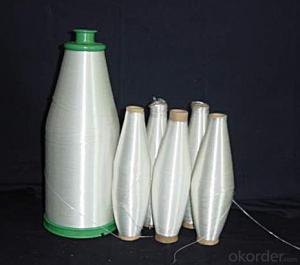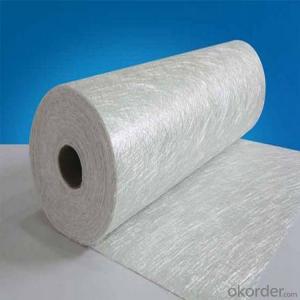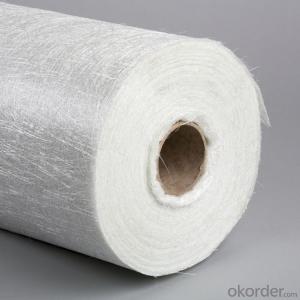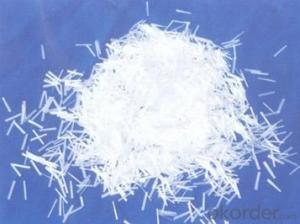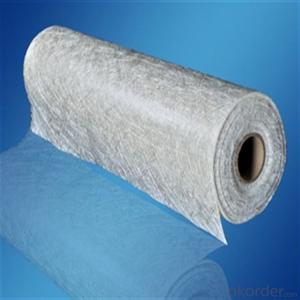Perforated Release film-vacuum infusion process
- Loading Port:
- Shanghai
- Payment Terms:
- TT or LC
- Min Order Qty:
- 200 m²
- Supply Capability:
- 20000 m²/month
OKorder Service Pledge
OKorder Financial Service
You Might Also Like
Perforated Release film
Product Description
Release film is a auxiliary material which is a isolation material in the process of composite production. It can be made into perforated and non perforated types. The perforated type is applied between the composite and suction rubber, and the non perforates type is applied between the suction rubber and molding.
Technique Data
Material:PE
Pore diameter:0.8mm ±0.2mm
Pitch:8mm±0.1mm
Thickness:30μ
Max. working temperature:120 ℃
Tensile strength:>25MPa
Elongation:>200%
Width:≤1.5m ±2mm
Length:600m or According to the request

- Q:Can fiberglass chopped strand be used in electrical grounding applications?
- No, fiberglass chopped strand should not be used in electrical grounding applications. Fiberglass is a non-conductive material, meaning it does not conduct electricity. In electrical grounding applications, a conductive material is required to ensure the safe dissipation of electrical charges. Copper or other metals are typically used for this purpose as they have good electrical conductivity.
- Q:How is fiberglass chopped strand used in composite materials?
- Fiberglass chopped strand is commonly used in composite materials as a reinforcement. It is added to a resin matrix, such as epoxy or polyester, to create a strong and durable composite. The chopped strands help enhance the mechanical properties of the material, such as tensile strength and impact resistance, making it ideal for applications in various industries, including automotive, aerospace, and construction.
- Q:What are the different forms of fiberglass chopped strand available?
- There are several different forms of fiberglass chopped strand available, including continuous strand mat, chopped strand mat, woven roving, and chopped strand.
- Q:Is fiberglass chopped strand suitable for automotive applications?
- Yes, fiberglass chopped strand is suitable for automotive applications. It is commonly used in automotive parts such as body panels, hoods, and interior components due to its high strength, lightweight, and corrosion-resistant properties. Additionally, it provides excellent impact resistance and can be easily molded into complex shapes, making it an ideal material for automotive applications.
- Q:How to design toxic liquid container on ordinary pressure? ?
- Color should be in accordance with the provisions of Table 3, It is not easy to fall off with tank welding and repair welding. First smear the soap water in outside of the tube and immerse it under the water.12.4 ~ 4 and.4, moisture tank rubber products corrosive liquid fire equipment in the store, corrosion resistance and oil resistance, liquid injection port sealing test technology of.4 file includes the following.7.4.4 tank hole and liquid injection port 4.5 strength layer the corrosion resistant resin as base material 11 tank factory inspection surface hardness value should reach 34 or more. 4; 484-1999 T automotive paint coating 3 defines this standard using the following definitions.1.2.3 4. 3, its minimum wall less than 5mm End socket should be oval-shaped one Nitrogen should be set in the right side with the resin content 30%-50% Close the inlet valve Set crosswise swash plate in the tank. Test bench test on a dedicated vent valvechecking table . 5.3.2 Tank mark a) The tank must be sprayed around the center line of the level of the tank to present the variety of the thing which is transporting: a) Name of manufacturing unit. 5, the test method according to the 5, the outer surface should be smooth and bright, so that the oxygen content is 18% ~ 23% (volume ratio).
- Q:What are the applications of fiberglass chopped strand?
- The unique physical and mechanical properties of fiberglass chopped strand allow for a wide range of applications. Here are some common uses: 1. Composite materials reinforcement: Fiberglass chopped strand is widely utilized as reinforcement in composite materials like fiberglass-reinforced plastics (FRP). By mixing the strands with resin, a strong and lightweight material is created, which finds extensive use in industries such as automotive, aerospace, construction, and marine. 2. Insulation: Fiberglass chopped strand is commonly employed as insulation material across various applications. Its excellent thermal insulation properties make it suitable for insulating walls, roofs, pipes, and appliances. Additionally, fiberglass insulation provides soundproofing capabilities, making it ideal for noise reduction applications. 3. Filtration and separation: The fine fibers of fiberglass chopped strand find use in filtration and separation processes. They can be manufactured into filter media to remove impurities from air, water, oil, and other fluids. HVAC systems, industrial applications, and even face masks commonly utilize fiberglass filters. 4. Electrical insulation: The high dielectric strength and resistance to electrical conductivity of fiberglass chopped strand make it a popular choice for electrical insulation. It is commonly found in electrical cables, transformers, circuit boards, and other electrical components to prevent electrical current leakage and ensure safety. 5. Concrete reinforcement: Fiberglass chopped strand is also employed as a reinforcement material in concrete structures. It enhances the strength and durability of concrete, making it suitable for applications such as bridges, roads, tunnels, and buildings. Fiberglass-reinforced concrete (FRC) provides improved resistance against cracking, impact, and corrosion. 6. Automotive applications: The automotive industry extensively utilizes fiberglass chopped strand for various purposes. It is commonly used in the production of car bodies, interior panels, bumpers, and other components. The lightweight nature and high strength properties of fiberglass make it an ideal material for improving fuel efficiency and overall performance. These examples highlight the versatility, durability, and cost-effectiveness of fiberglass chopped strand, making it a favored choice across diverse industries and applications.
- Q:How is the dimensional stability of fiberglass chopped strand maintained?
- The dimensional stability of fiberglass chopped strand is primarily maintained through the use of proper manufacturing techniques and specific additives. During the manufacturing process, the glass fibers are carefully aligned and distributed evenly throughout the composite material. This ensures that the fibers are evenly dispersed, minimizing any potential shrinkage or expansion that may occur. Furthermore, the use of specific additives, such as binders and sizing agents, also contributes to the dimensional stability of fiberglass chopped strand. These additives help to improve the adhesion between the glass fibers and the matrix material, creating a strong bond that reduces the risk of dimensional changes over time. Additionally, the proper curing and cooling processes further enhance the dimensional stability of fiberglass chopped strand. By applying controlled heat and pressure during the curing process, the composite material is able to set and solidify in a way that minimizes any potential distortions or changes in shape. Proper cooling techniques are also employed to ensure that the composite material retains its desired dimensions. Overall, a combination of manufacturing techniques, additives, and curing processes are employed to maintain the dimensional stability of fiberglass chopped strand. These measures help to ensure that the composite material remains structurally sound and retains its intended shape over time.
- Q:What are the storage requirements for fiberglass chopped strand?
- The storage requirements for fiberglass chopped strand primarily focus on maintaining the quality and integrity of the material. It is important to store fiberglass chopped strand in a dry and well-ventilated area to prevent moisture absorption, as excess moisture can lead to product degradation and performance issues. Additionally, the storage area should be free from direct sunlight and extreme temperature fluctuations, as these factors can also negatively impact the material's properties. It is recommended to store the chopped strand in its original packaging or in sealed containers to protect it from dust, dirt, and other contaminants. By following these storage requirements, the fiberglass chopped strand can be preserved in optimal condition, ensuring its effectiveness and longevity in various applications.
- Q:Can fiberglass chopped strand be used in water treatment applications?
- Yes, fiberglass chopped strand can be used in water treatment applications. It is commonly used in the construction of water treatment tanks, pipes, and vessels due to its corrosion resistance, high strength, and durability. Additionally, fiberglass chopped strand can be used in the fabrication of filtration media, such as filter beds and packed towers, to remove impurities from water.
1. Manufacturer Overview |
|
|---|---|
| Location | |
| Year Established | |
| Annual Output Value | |
| Main Markets | |
| Company Certifications | |
2. Manufacturer Certificates |
|
|---|---|
| a) Certification Name | |
| Range | |
| Reference | |
| Validity Period | |
3. Manufacturer Capability |
|
|---|---|
| a)Trade Capacity | |
| Nearest Port | |
| Export Percentage | |
| No.of Employees in Trade Department | |
| Language Spoken: | |
| b)Factory Information | |
| Factory Size: | |
| No. of Production Lines | |
| Contract Manufacturing | |
| Product Price Range | |
Send your message to us
Perforated Release film-vacuum infusion process
- Loading Port:
- Shanghai
- Payment Terms:
- TT or LC
- Min Order Qty:
- 200 m²
- Supply Capability:
- 20000 m²/month
OKorder Service Pledge
OKorder Financial Service
Similar products
New products
Hot products
Hot Searches
Related keywords
